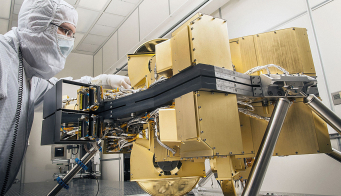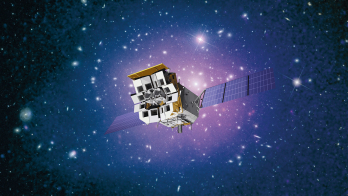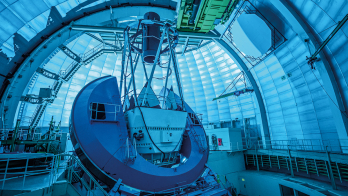GRB 080319B is the plain name for an extraordinary gamma-ray burst (GRB) that was so bright that it could be seen with the unaided eye for 30 s. The detailed observation of the prompt optical emission and the follow-up monitoring of the afterglow place strong constraints on theoretical models.

Image credit: NASA/Swift/Stefan Immler et al.
For GRB hunters 19 March 2008 was a red-letter day. NASA’s Swift spacecraft, which has been providing GRB highlights since its launch in November 2004 (CERN Courier December 2005 p20), detected a record of four bursts on a single day, the second of which, GRB 080319B, was the brightest ever observed. Luckily, after a journey of 7000 million years (redshift z = 0.937), the GRB photons reached Chile at nighttime, where two wide-field optical cameras were patiently gazing at the sky. The strategy to observe the same region as Swift is monitoring allowed the TORTOREM and the Pi of the Sky collaborations to follow the evolution of the optical flash during the GRB. The brightness of GRB 080319B measured by the TORTORA camera mounted on the 60 cm robotic Rapid Eye Mount telescope at La Silla and by the Pi of the Sky apparatus at Las Campanas Observatory exceeded sixth magnitude, making this GRB the first cosmological object visible to the naked eye.
This observational breakthrough together with the usual multiwavelength afterglow observations of this extremely bright GRB provide an excellent opportunity for testing theoretical models. Based on their link to supernova explosions (CERN Courier September 2003 p15), it is widely agreed that long GRBs result from the core collapse of a dying star and are emitted by highly relativistic ejecta moving in a direction close to the line of sight. There is, however, an ongoing debate about the physical processes at the origin of the GRB and its long-lasting afterglow emission. In the standard "fireball" model, both the prompt GRB and its afterglow are synchrotron emission by electrons accelerated by shock waves in a relativistic jet. The prompt emission arises from internal shocks, while the afterglow is produced when the jet plunges into gas surrounding the dying star.
J S Bloom of the University of California and colleagues have difficulties in reconciling this standard scenario with the observed spectral and temporal variations of GRB 080319B. The simultaneous optical and gamma-ray fluctuations led P Kumar of the University of Texas and A Panaitescu of the Los Alamos National Laboratory to propose the same emission site for the optical photons and the gamma rays. However, as a single spectral component does not match the observed optical and gamma-ray radiation, they suggest that relativistic electrons produce optical synchrotron photons that they up-scatter to gamma-ray energies via inverse-Compton interactions. S Dado, from the Technion institute in Haifa and colleagues from CERN share the opinion that the gamma-ray emission is not of synchrotron origin but, in their "cannonball" model, the seed photons for Compton up-scattering are light from the supernova reflected towards a plasmoid that is ejected from the centre of the dying star by a newborn black hole.
Even though GRB 080319B does not decide on the issue of which of these three models is right, it provides stringent observational constraints that have to be accounted for by future GRB theories.







